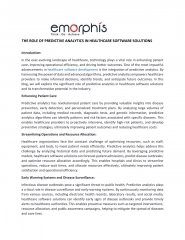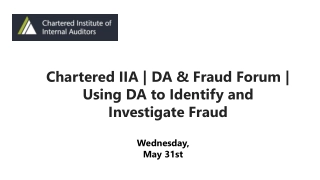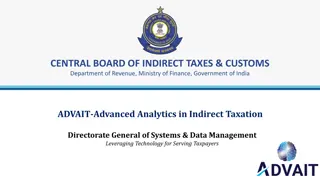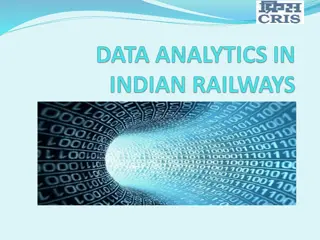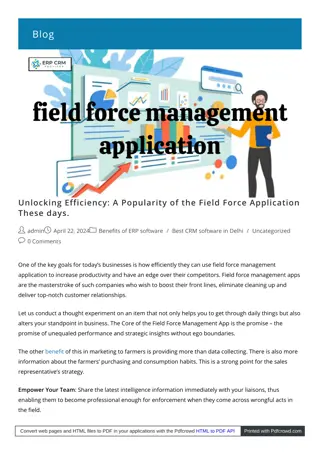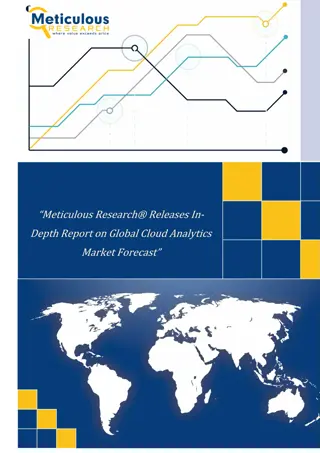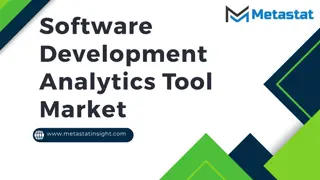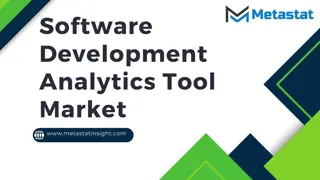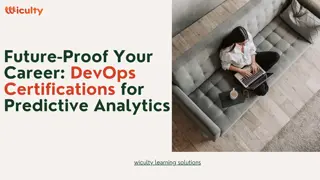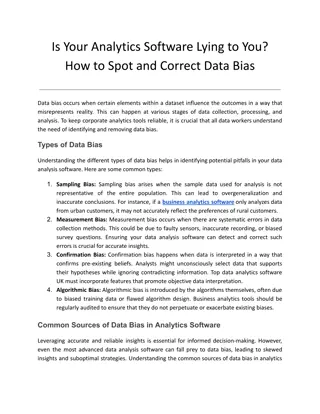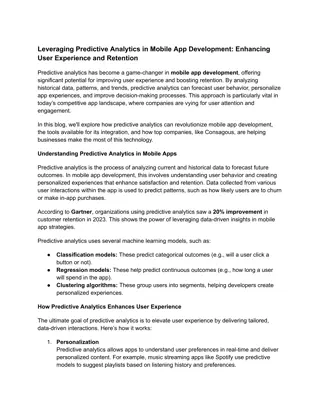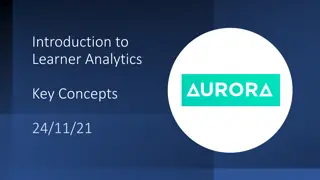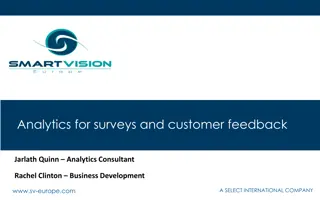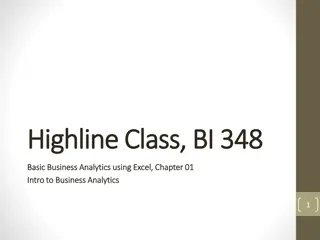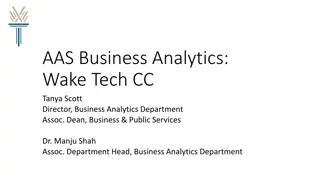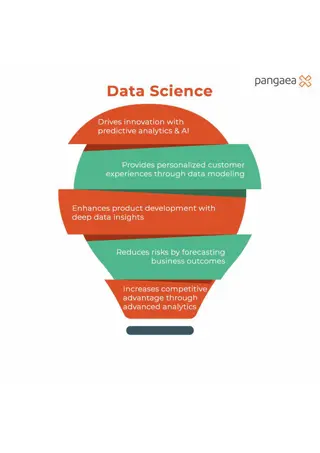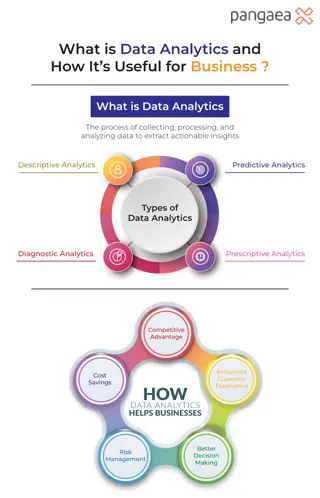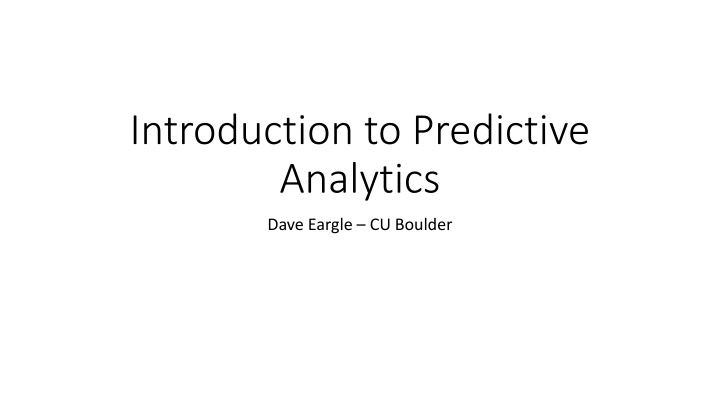
Predictive Analytics and Data Mining
Explore the fundamentals of predictive analytics and data mining, including terminology, supervised data mining subclasses, and the difference between data mining and model usage. Learn how to apply linear regression and association analysis for predictive modeling in practice.
Download Presentation

Please find below an Image/Link to download the presentation.
The content on the website is provided AS IS for your information and personal use only. It may not be sold, licensed, or shared on other websites without obtaining consent from the author. If you encounter any issues during the download, it is possible that the publisher has removed the file from their server.
You are allowed to download the files provided on this website for personal or commercial use, subject to the condition that they are used lawfully. All files are the property of their respective owners.
The content on the website is provided AS IS for your information and personal use only. It may not be sold, licensed, or shared on other websites without obtaining consent from the author.
E N D
Presentation Transcript
Introduction to Predictive Analytics Dave Eargle CU Boulder
Terminology Model A simplified representation of reality crated to serve a purpose Predictive Model A formula for estimating the unknown value of interest: the target The formula can be mathematical, logical statement (e.g., rule), etc. Prediction Estimate an unknown value (i.e. the target) Instance / example: Represents a fact or a data point Described by a set of attributes (fields, columns, variables, or features) Model induction: The creation of models from data Training data: The input data for the induction algorithm
Subclasses of Supervised Data Mining Classification Categorical target Often binary Includes class probability estimation Regression Numeric target
Subclasses of Supervised Data Mining Will this customer purchase service ?1 if given incentive ?1? Classification problem Binary target (the customer either purchases or does not) Which service package (?1, ?2, or none) will a customer likely purchase if given incentive ?1? Classification problem Three-valued target How much will this customer use the service? Regression problem Numeric target Target variable: amount of usage per customer
Data Mining versus Use of the Model Supervised modeling: Data Model Data Mining Training data have all values specified Model in use: New data item prediction Model New data item has some value unknown (e.g., will she leave?)
Lets do it! Download demographic_data_orig.csv Let s predict the amount of the sale What kind of data type is that target variable? Continuous So we ll use Linear Regression Take a random sample of 2k rows, because otherwise the modeling takes a long time Set region to be a string-type Do an Association Analysis, compare amount and age compare amount and item which is a good candidate for a model? Do a Plot of Means compare Region and amount is it a good candidate for a predictive model? Linear Regression, add all `Browses` investigate the Interactive report Score it
How to interpret? `Amount` is predicted by a combination of `region` and `age`
How to interpret? These are beta estimates (B), or weights. To calculate a prediction, you just use these numbers If your model only had `age` in it (this one has more than just `age`), you would make a prediction like this: amount = intercept + B_age * x_age if someone were 40 years old, amount = 890 + -3.547*(40) amount = 748.12
Dummy-Coding Say you have one categorical feature with four values (levels): Region: { north , south , west , east } You want to create a linear model that includes that feature as a predictor e.g., ????? = ????????? + ???? ????+ ???? ?? ???????! How do you include the categorical variable in the model? How do you calculate an estimate (B) for the impact of its levels? You need a numerical value you can plug into your formula So, dummy-code it! For a feature with n levels, replace that feature with ? 1 dummy binary variables Then, your model estimates ? s for each dummy variable separately ????? = ????????? + ???? ????+ ???????2 ???????????2+ ???????3 ???????????3+ ???????4 ???????????4 Then, when making a prediction with age=40 and region=2, ????? = ???????? + ???? 40 + ???????2 1 + ???????3 0 + ???????4 0 What about region1? It s built into the intercept
How to interpret? These are beta estimates (B), or weights. To calculate a prediction, you just use these numbers Region has been dummy-coded one feature with 4 different values have been replaced with 3 features that are only ever 0 or 1. To make a prediction, amount = intercept + B`age` * age + B`region2` * region2 + B`region3` * region3 + B`region4` * region4 For example, for someone in region 2 who is 50: amount = 890.394 + -3.547*50 + (-431.946)*1 + 203.549*0 + 590.613*0 amount = 281.098
How to interpret? These tell you how good the model is. E.g., how close are the predicted values to the actual values? More on this later.
All of this is also available in the interactive report for a Linear Regression
If extra time Download luxury_shoes_trimmed.csv We re going to predict the maximum price at which a shoe has ever been listed What kind of data type is that target variable? Continuous So we ll use Linear Regression Filter to just records that have a `rating` -- should result in ~2k rows `Select` just `rating`, `brand`, `price.amountMax`, `price.amountMin` Do an Association Analysis Linear Regression, add all `Browses` investigate the Interactive report
Many figures in this slide deck from Provost, F., & Fawcett, T. (2013). Data science for business: what you need to know about data mining and data-analytic thinking. Sebastopol, Calif.: O'Reilly.

